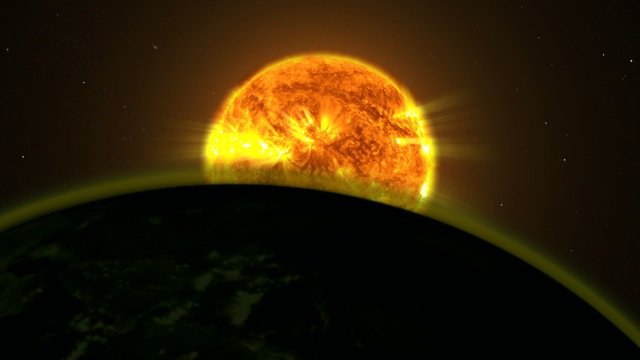COLLEGE PARK, Md. - Using the powerful eye of NASA's Hubble Space Telescope, two University of Maryland-led teams of scientists have found faint signatures of water in the atmospheres of five distant planets.
The presence of atmospheric water was reported previously on a few exoplanets – planets orbiting stars beyond our solar system. However, this is the first study to conclusively measure and compare the profiles and intensities of these signatures on multiple worlds.
University of Maryland astronomy professor L. Drake Deming led the census of exoplanet atmospheres that produced the new findings. Deming and colleagues characterized two of the five planets in a study published Sept. 10 in Astrophysical Journal. The findings for the three other exoplanets were reported in the same journal today.
"To actually detect the atmosphere of an exoplanet is extraordinarily difficult. But we were able to pull out a very clear signal, and it is water," said Deming, an expert at using data from space and ground-based telescopes to deduce the characteristics of exoplanets, from massive "hot Jupiters" to planets with more Earth-like traits.
"We're very confident that we see a water signature for multiple planets," said Avi Mandell, a planetary scientist at NASA's Goddard Space Flight Center in Greenbelt, Md., and lead author of the journal article published today. "This work really opens the door for comparing how much water is present in atmospheres on different kinds of exoplanets, for example hotter versus cooler ones."
The observations are the latest in a wave of new insights about exoplanets, made possible by new information from Hubble and NASA's Kepler space telescope, which searches a nearby region of the Milky Way for Earth-sized planets capable of supporting liquid water.
These exceptionally challenging studies can be done only if the planets are spotted while they are passing in front of their stars. Researchers can identify the gases in a planet's atmosphere by determining which wavelengths of the star's light are transmitted and which are partially absorbed. Deming's team employed a new technique with longer exposure times, which increased the sensitivity of their measurements.
In both studies, scientists used Hubble's Wide Field Camera 3 to explore the details of absorption of light through the planets' atmospheres. The observations were made in a range of infrared wavelengths where a pattern that signifies the presence of water would appear if water were present. The teams compared the shapes and intensities of the absorption profiles, and the consistency of the signatures gave them confidence they saw water.
The five planets -- WASP-17b, HD209458b, WASP-12b, WASP-19b and XO-1b -- orbit nearby stars. The strengths of their water signatures varied. WASP-17b and HD209458b had the strongest signals. The signatures for the other three planets, WASP-12b, WASP-19b and XO-1b, also are consistent with water.
The Sept. 10 research paper described findings for HD209458b and XO-1b, while today's publication describes WASP-12b, WASP-17b and WASP-19b.
The five planets are hot Jupiters, massive worlds that orbit close to their host stars. The researchers were initially surprised that all five appeared to be hazy. But Deming and Mandell noted that other researchers are finding evidence of haze around exoplanets.
"These studies, combined with other Hubble observations, are showing us that there are a surprisingly large number of systems for which the signal of water is either attenuated or completely absent," said Heather Knutson of the California Institute of Technology, a co-author on Deming's paper. "This suggests that cloudy or hazy atmospheres may in fact be rather common for hot Jupiters."















